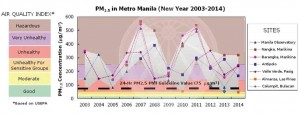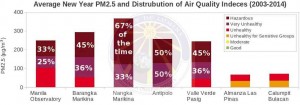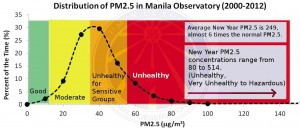Worst air pollution episode

FIGURE 1. The view of the Marikina Valley from the Manila Observatory in Quezon City at the stroke of midnight (A) of 2014. At 6 a.m., the view (B) was obscured by smoke from fireworks and firecrackers. By afternoon, the air had cleared up. The mountain range and buildings in the valley (C) at 5 p.m. and the lights from the valley (D) on the evening of Jan. 1 were visible. PHOTO AND GRAPHS COURTESY OF MANILA OBSERVATORY
New Year in and around Metro Manila was smoggy, with the worst air pollution episode of the year.
This was due to the many commercial and homemade firecrackers and fireworks that were set off beginning in the afternoon of New Year’s Eve, peaking at midnight.
The majority of the population in Metro Manila participated in the revelry, explaining the huge amounts of harmful smoke produced during this time and the consequent drastic reduction in visibility.
These factors, combined with increased moisture and calm wind, contributed to keeping the air pollution levels dangerous into the wee hours of the morning of January 1.
Manila Observatory
A dramatic decrease in visibility in the Manila Observatory in Quezon City during the New Year can be seen in Figures 1A and 1B.

FIGURE 2. Twenty-four-hour PM2.5 concentrations were sampled with low volume air samplers from 12 p.m. of Dec. 31 to 12 p.m. of Jan. 1 in the following sites (some sites do not have samples for all the years): Manila Observatory, Quezon City; Nangka, Marikina City; Barangka, Marikina City; Oro Vista Royale, Antipolo City; Valle Verde 5, Pasig City; Almanza, Las Piñas City; and Calumpit, Bulacan. PHOTO AND GRAPHS COURTESY OF MANILA OBSERVATORY
The Marikina Valley and the Sierra Madre mountains in the background were obscured by smoke from midnight (Figure 1A) to the early morning (Figure 1B) of the New Year.
By afternoon, (Figure 1C) the air had cleared up and the structures in the Marikina Valley and the Sierra Madre mountains were visible.
In the evening (Figure 1D), lights from the Marikina Valley were already visible.
The Manila Observatory, a private, nonprofit Jesuit research institution, has been monitoring fine particulate matter (PM2.5) since 2003 in different locations in Metro Manila during the New Year.
Minute particles
PM2.5 is a collective name for particles 2.5 microns in diameter or smaller. Because they are minute, the particles can be carriers of toxic gases, can burrow deep into the respiratory system and can therefore have negative impact on health.

FIGURE 3. The highest average PM2.5 concentration over the years was measured in Nangka, Marikina City, where PM2.5 was hazardous 67 percent of the time. PM2.5 was similarly distributed in the Manila Observatory; Barangka, Marikina City; Antipolo City; and Pasig sites where levels were hazardous to very unhealthy most of the time. The lowest PM2.5 was measured in Las Piñas City and Bulacan, where PM2.5 was unhealthy. PHOTO AND GRAPHS COURTESY OF MANILA OBSERVATORY
Results of air quality measurements from the New Year from seven sampling sites were plotted over a colored background that represents the United States Environmental Protection Agency (US EPA) Air Quality Index ranges in Figure 2.
Air quality indices indicate the associated health effects of PM2.5 concentrations. PM2.5 (24-hour average) in Quezon City, Marikina City, Antipolo City and Pasig City were in the hazardous range (>251 mg/m3) of the US EPA Air Quality Index 42 percent of the time.
Remain indoors
When the air reaches hazardous levels, everyone should remain indoors and keep activity levels low, else serious health effects may occur.
Windows and doors should be shut, or the area vacated until the air quality improves.
Almost all (94 percent) of the past New Year PM2.5 concentrations were much higher than the 24-hour guideline value of 75 mg/m3 (red line in Figure 2) set by the Philippine government.
Highest, lowest
Levels were highest in 2007 and 2011, and lowest in 2005 and 2009.
Although there were air quality improvements in 2005 and 2009 (dip in PM2.5 in Figure 2), these were slight relative to their implications on health.

FIGURE 4. This graph of PM2.5 in the Manila Observatory in Quezon City, overlaid with the US EPA Air Quality Indices, shows concentrations that are normally in the moderate to unhealthy range for sensitive groups. New Year PM2.5 readings of more than 10 times the normal PM2.5 values were monitored. The air became very unhealthy to hazardous during the New Year. PHOTO AND GRAPHS COURTESY OF MANILA OBSERVATORY
PM2.5 concentrations then were still in the very unhealthy range, meaning everyone should avoid physical activity outdoors and sensitive groups (young, old and those with respiratory difficulties) should remain indoors and keep activity levels low. Otherwise, serious health effects may occur.
This and last year’s PM2.5 concentrations were almost half of those in 2007 and 2011, when levels were highest and all measurements were in the hazardous range. Yet, four of the seven sites still had hazardous air this new year.
Figure 3 shows that the highest measurements through the years were from Nangka in Marikina City (320 mg/m3: 24-hour average), which is located in a valley that traps pollutants naturally and where 67 percent of the time the New Year air was hazardous.
Lowest in Las Piñas
PM2.5 was also very high in Barangka, Marikina, (294 mg/m3) and in Oro Vista Royale near Marcos Highway in Antipolo City (257 mg/m3), where the air was hazardous most of the time.
The lowest PM2.5 was measured in Las Piñas and Bulacan, away from the Metro Manila center, though the levels were still in the unhealthy range.
In all the sites, the air was at the very least unhealthy and there have been no New Years since 2003 when the air quality was good or moderate.
In the Manila Observatory, where there have been PM2.5 readings since 2000, the New Year PM2.5 values were up to more than 10 times the normal values (40 mg/m3 in Figure 4).
New Year PM2.5 values were the highest measurements of each year. These were the only measurements of the year that reached the very unhealthy and hazardous ranges of the US EPA Air Quality Index.
No significant improvement
More than 10 years of monitoring PM2.5 around Metro Manila shows no significant improvement in the New Year air quality. And this is in addition to the normal state of our air, which by itself already needs to be improved.
One wonders, therefore, if the hazardous air and other risks (fires, injuries and lives lost) associated with each New Year is actually worth all the celebration.
Perhaps, some hope lies in the future when individuals and communities can resort to more healthy and responsible ways of welcoming the New Year.
(Genie Lorenzo and Melliza Cruz are research associates; Nofel Lagrosas, Ph.D. is a scientist; James Simpas, Ph.D. is the head of the air quality dynamics and instrumentation, and technology development programs; and Gemma Narisma, Ph.D. is the associate director for research—all at the Manila Observatory.)




















